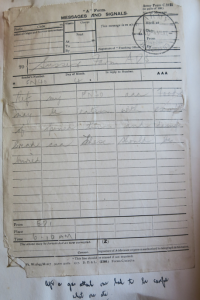30th May 1917 Wednesday
All material produced or reproduced here and throughout this work is the sole copyright of the author and the family of Doctor D.C.M. Page MC.
The ever-present threat of gas attack played on the minds of the men. The thought of suffering endless artillery barrages laced with the terror of gas is difficult to imagine. We have already heard about the various alarm systems and how applying the respirators and gas masks to men and animals would be carried out within seconds. Among other measures to be taken were special instructions as to how to deal with contamination.
“One day all the guns on the 2nd Army Front bombarded the German front line and blew it to ‘blazes’. The shrapnel barrage was a sight worth seeing, at the same time we put up a smoke barrage, and filled our front trench with dummies in order to draw enemy fire and spot the position of his guns. However, the wily old Bosche kept his guns quiet. He had evidently spotted the ruse. He retaliated later on in the evening and we had many casualties. Ypres was very heavily shelled, and starting at 11.30pm he kept up an all-night bombardment of Salvation Corner with gas, tear and flame shells. It was a terrible sight. The gas blew over to our dug-outs, on the canal bank, and we soon all began to cough, and our eyes to water. Gas respirators were donned, and had to be worn all night. For days after I felt extremely tired, and had a headache, sinking sensation in the stomach and rapid pulse. I vomited severely at night, and felt better afterwards. No doubt the gas had affected me before I got my respirator on. We had to deal with a lot of gas casualties after this night of terror – 80 cases in all. The Huns used phosgene gas along with the Lachrymatory or tear shells. The 39th Division had over 80 cases of gas poisoning.”
Find out about our connection with Dr Page and an introduction to his diary here
